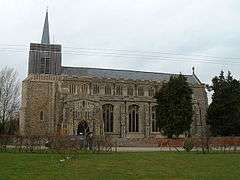Bildeston
Bildeston is a village and civil parish in the Babergh district of Suffolk, England. Located around 5 miles (8 km) north of Hadleigh, in 2005 it had a population of 960, increasing to 1,054 at the 2011 Census.[1]
| Bildeston | |
|---|---|
 St Mary's Church, Bildeston | |
 Bildeston Location within Suffolk | |
| Area | 3.79 km2 (1.46 sq mi) |
| Population | 1,054 (2011) |
| • Density | 278/km2 (720/sq mi) |
| District | |
| Shire county | |
| Region | |
| Country | England |
| Sovereign state | United Kingdom |
| Post town | IPSWICH |
| Postcode district | IP7 |

| |
History
According to Eilert Ekwall the meaning of the village name is Bild's homestead.
According to 'Bildeston Church and Village' by Sue Andrews, the village came into existence around 1,100 years ago. Although two Roman roads crossed here, little evidence has been found of any Roman settlement, only of Bildr, supposedly, seven centuries later, as an invading Danish leader, whose name the first settlement is thought to have adapted.
The first real evidence of Bildeston is in the Domesday Book. The manor had been a royal estate of Queen Edith, consort of Edward the Confessor. By 1086 there were 20 households, composed of villeins, bordars and serfs, all dependent on Walter the Deacon, the absentee Lord of the Manor. Three plough teams belonged to the villagers, three to the lord and another to the priest, whose church was presumably where St Mary Magdalene’s is today. One hundred years later the church was said to have been re-built by Lady Helewise de Gwerres, whose family, the Loveynes, later became the lords of the Manor.
Despite mythology explaining the move of the village down to the Brett valley as being caused by the Black Death of 1349, Matthew de Loveyne, then lord of the manor, was granted a charter for a market on the Stowmarket to Hadleigh Road in 1264. The move was to be more gradual and possibly more to do with easily accessible water. When the Revett family took over the manor in 1603 only the manor house and the church remained on the comparatively bleak hill, although houses on the road to the church were shown on early 19th century maps.
Bildeston became famous for blue broadcloth and buildings housing dyers, weavers, shearmen, spinners and clothiers were erected to form Chapel Street and Duke Street during the 15th and 16th centuries. Also constructed was a wool hall where the commerce of the wool trade was conducted. It is very similar to the one that can be seen restored to its original form as part of the Swan Hotel in nearby Lavenham. The Bildeston Hall still survives but is now split into two private residences on the corner of High Street and Ipswich Road. Early enclosure of agricultural land had created a landless population for enterprising landlords to profit by. But by the reign of Queen Mary (1553–58) scarcity and high prices lead to reports 'whereby this town of Bilstone hath decayed'.
Changes in fashion and foreign policy that interrupted trade meant the main employment became the supplying of yarn to Norwich instead of quality cloth to London. By 1674 two thirds of households were living in poverty and many were taken into the village workhouse. The Crown Inn became a centre for the casual hiring of farm labourers and domestic servants.
The weekly Wednesday market failed in 1764 and traveller John Kirby described Bildeston as 'a town in a bottom, meanly built and the streets are dirty'. The manor house was demolished, following the death of Bartholomew Beale the last lord of the manor 40 years before. The Cooke family of Polstead ostensibly took over the rents and the profits of the fair, but took little interest in the village. The last fair was held in 1872, with just one stall.
So called 'professional' people settled in the 19th century, there were plans to build a railway station on Dansford Meadow and the Riot Act was read during the 1885 elections. Bildeston, like so many other Suffolk villages, had survived a long period of decline, to again achieve relative affluence.
Bildeston Hall
Bildeston Hall, occasional home to lords who often had interests elsewhere, was to the south west of the church. Ploughing in 1974 removed remains of a circular moat and what may have been a fish pond, but did produce pottery from the 11th to 17th centuries. The crop marks, seen from the air, can still reveal the site of the original Bildeston.
Present day
Today, Bildeston is a thriving village once more, boasting a post office and general provisions shop and three pubs. The King's Head, a Grade II listed freehouse dating from around 1530, organises an annual beer festival at the end of May.[2] The other pubs in the village are a gastropub The Crown[3] and The Red Lion. Previously known as The Lion, the Red Lion is a traditional 16th-century locals' pub with the current building thought to mainly date from the 18th century. The pub was situated in Wattisham, until 18 August 1882, when a detached portion of that parish was incorporated into Bildeston Parish; it was the only building in the detached portion of Wattisham.[4]
St Mary Magdalene Church
St Mary Magdalene Church now stands isolated, about half a mile from Bildeston. On the morning of 8 May 1975 the church tower collapsed. The tower was undergoing radical maintenance at the time, and the medieval bells had already been removed. The replacement tower is topped by a bare, functional box, with a slender little spire on top. The south porch has grand flushwork, a testimony to 15th century piety and Marian devotion. The doorway must be among the best in the county of its period. St Mary’s also boasts a glorious window by the Kempe workshop, depicting the Annunciation and richly adorned with subsidiary scenes.[5]
On 23 January 1958, the church was designated as a Grade I listed building, the highest ranking and one denoting a building of exceptional interest.[6]
References
- "Parish population 2011". Retrieved 11 September 2015.
- "Kings Head, Bildeston - Home". Bildestonkingshead.co.uk. Archived from the original on 28 June 2014. Retrieved 22 August 2014.
- "Home". The Bildeston Crown. 20 June 2014. Retrieved 22 August 2014.
- https://suffolk.camra.org.uk/pub/61
- "St Mary, Bildeston". Suffolk Churches. Simon Knott. Retrieved 28 January 2017.
- Historic England. "Church of St Mary Magdalene (Grade I) (1037449)". National Heritage List for England. Retrieved 1 November 2018.